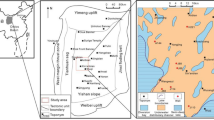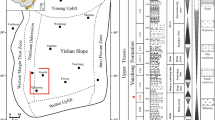Abstract
Tight oil reservoirs account for a large portion of hydrocarbon resources in continental basins. The Chang 7 Member of the Upper Triassic Yanchang Formation in the Ordos Basin is a well-known high-quality source rock in China and considerable petroleum resources have been found in its tight oil sandstone reservoirs. This study uses thin sections, constant-rate mercury injection, mercury injection, scanning electron microscopy, and the fractal dimension to study its mineral compositions and pore structure and to discuss the effects of cement mineralogy and pore structure on reservoir physical property. Tight oil sandstone reservoirs in Chang 7 Member mainly consist of gray and grayish green medium-fine-grained lithic arkose, feldspathic litharenite, and litharenite. Feldspar dissolved pores are the most developed pores in the reservoirs, followed by intergranular pores and lithic dissolved pores. Throats of the reservoirs are mainly in pore shrinkage type, neck type, sheet type, and bent sheet type. The tight oil sandstone reservoirs have complex pore structure and with the increasing radius, the structure of throats becomes simpler, while the structure of pores becomes more complex. According to median radius of pore-throat, the maximum mercury intrusion saturation, and extrusion efficiency, the reservoirs can be divided into three types: micro throat-high mercury intrusion saturation type with high physical property, adsorptive throat-medium mercury intrusion saturation type with medium physical property, and micro adsorptive throat-low mercury intrusion saturation type with low physical property. Ferrocalcite and illite are the main cements reducing reservoir physical property, while chlorite cement can protect the reservoir physical property to some extent. In microscopic pore structure parameters, except pore-throat skewness, median radius of pore-throat, pore-throat ratio, pore-throat sorting coefficient, and the fractal dimension of big pore-throats, can affect reservoir physical property.













Similar content being viewed by others
References
Berger G, Lacharpagne JC, Velde B, Beaufort D, Lanson B (1997) Kinetic constraints on illitization reactions and the effects of organic diagenesis in sandstone/shale sequences. Appl Geochem 12:23–35
Bjørlykke K, Ramm M, Saigal GC (1989) Sandstone diagenesis and porosity modification during basin evolution. Geol Rundsch 78:243–268
Camp WK (2011) Pore-throat sizes in sandstones, tight sandstones, and shales: discussion. AAPG Bull 95:1443–1447
Cao Z, Liu GD, Kong YH, Wang CY, Niu ZC, Zhang JY, Geng CB, Shan X, Wei ZP (2016) Lacustrine tight oil accumulation characteristics: Permian Lucaogou Formation in Jimusaer Sag, Junggar Basin. Int J Coal Geol 153:37–51
Chen ZM, Liao XW, Zhao XL, Zhu LT, Liu HM (2016) Performance of multiple fractured horizontal wells with consideration of pressure drop within wellbore. J Pet Sci Eng 146:677–693
Dou WC, Liu LF, Wu KJ, Xu ZJ, Feng X (2017) Diagenesis of tight oil sand reservoirs: Upper Triassic tight sandstones of Yanchang Formation in Ordos Basin, China. Geol J 53:1–18
Dou WC, Liu LF, Wu KJ, Xu ZJ, Liu XX, Feng X (2018) Diagenetic heterogeneity, pore throats characteristic and their effects on reservoir quality of the Upper Triassic tight sandstones of Yanchang Formation in Ordos Basin. China Mar Pet Geol 98:243–257
Editorial Committee of Petroleum Geology of Changqing Oilfield (1992) Chinese petroleum geological records (In Chinese). Petroleum Industry Press, Beijing, pp 8–145
Fu JH, Guo ZQ, Deng XQ (2005) Sedimentary facies of the Yanchang Formation of Upper Triassic and petroleum geological implication in southwestern Ordos Basin. J Palaeogeogr 7:34–44 (in Chinese with English abstract)
Guo TK, Zhang SC, Ge HK, Wang XQ, Lei X, Xiao B (2015) A new method for evaluation of fracture network formation capacity of rock. Fuel 140:778–787
Guo YQ, Hui L, Zhang XN, Wei QS, Li WH, Li BQ (2018) Sedimentary system characteristics and lake basin evolution of Triassic Yanchang Formation in Ordos Basin. J Northwest Univ (Natural Science Edition) 48:593–602 (in Chinese with English abstract)
Guo HJ, Yuan L, Cheng YP, Wang K, Xu C (2019) Experimental investigation on coal pore and fracture characteristics based on fractal theory. Powder Technol 346:341–349
Hao LW, Tang J, Wang Q, Tao HF, Ma XF, Ma DX, Ji HJ (2017) Fractal characteristics of tight sandstone reservoirs: A case from the Upper Triassic Yanchang Formation, Ordos Basin, China. J Pet Sci Eng 158:243–252
Hu SY, Zhu RK, Wu ST, Bai B, Yang Z, Cui JW (2018) Profitable exploration and development of continental tight oil in China. Pet Explor Dev 45:737–748 (in Chinese with English abstract)
Ji LM, Wang SF, Xu JN (2006) Acritarch assemblage in Yanchang Formation in eastern Gansu province and its environmental implications. Earth Sci-J China Univ Geosci 31:798–806 (in Chinese with English abstract)
Ji LM, Zhu YH, Wang SF (2008) Studies of modality assemble of Botryococcus from the Triassic Yanchang Formation in the Ordos Basin, Northwest China. Acta Palaeontol Sin 47:185–194 (in Chinese with English abstract)
Jia CZ, Zou CN, Li JZ, Li DH, Zheng M (2012) Assessment criteria, main types, basic features and resource prospects of the tight oil in China. Acta Pet Sin 33:343–350 (in Chinese with English abstract)
Lai J, Wang GW, Ran Y, Zhou ZL, Cui YF (2016) Impact of diagenesis the reservoir quality of tight oil sandstones: the case of Upper Triassic Yanchang Formation Chang 7 oil layers in Ordos Basin, China. J Pet Sci Eng 145:54–65
Li WH, Pang JG, Cao HX, Xiao L, Wang RG (2009) Depositional system and paleogeographic evolution of the late Triassic Yanchang stage in Ordos Basin. J Northwest Univ (Natural Science Edition) 39:501–506 (in Chinese with English abstract)
Li RX, Guzmics T, Liu XJ, Xie GC (2011) Migration of immiscible hydrocarbons recorded in calcite-hosted fluid inclusions, Ordos Basin: a case study from Northern China. Russ Geol Geophys 52:1491–1503
Li DH, Liu ZY, Zhang GS, Zheng ZH, Jia J, Gao X, Zan X (2017) Comparison and revelation of tight oil accumulation conditions, distribution characteristics and development status between China and U.S. Nat Gas Geosci 28:1126–1138
Li XB, Liu HQ, Pan SX, Chen QL, Yan RW, Xu WL, Wang HB, Huang JP, Wang J (2018a) Subaqueous sandy mass-transport deposits in lacustrine facies of the Upper Triassic Yanchang Formation, Ordos Basin, Central China. Mar Pet Geol J 97:66–77
Li ST, Yao JL, Mou WW, Luo AX, Wang Q, Deng XQ, Chu MJ, Li Y, Yan CC (2018b) The dissolution characteristics of the Chang 8 tight reservoir and its quantitative influence on porosity in the Jiyuan area. Ordos Basin China J Nat Gas Geosci 3:95–108
Lin HB, Hou MC, Chen HD, Dong GY (2008) Characteristics and evolution of the sedimentary system of upper Triassic Yanchang Formation in Ordos Basin, China. J Chengdu Univ Technol (Science and Technology Edition) 35:674–680 (in Chinese with English abstract)
Liu KQ, Ostadhassan M, Sun LW, Zou J, Yuan YJ, Gentzis T, Zhang YX, Carvajal-Ortiz H, Rezaee R (2019) A comprehensive pore structure study of the Bakken Shale with SANS, N2 adsorption and mercury intrusion. Fuel 245:274–285
Ma J, Huang ZL, Liang SJ, Liu ZZ, Liang H (2016) Geochemical and tight reservoir characteristics of sedimentary organic-matter-bearing tuff from the Permian Tiaohu Formation in the Santanghu Basin, Northwest China. Mar Pet Geol 73:405–418
Ma Xf, Zhou T, Zou YS (2017) Experimental and numerical study of hydraulic fracture geometry in shale formations with complex geologic conditions. J Struct Geol 98:53–66
Mandelbrot BB (1983) The fractal geometry of nature. W.H. Freeman, New York
Nelson PH (2009) Pore-throat sizes in sandstones, tight sandstones, and shales. AAPG Bull 93:329–340
Padhy GS, Lemaire C, Amirtharaj ES, Ioannidis MA (2007) Pore size distribution in multiscale porous media as revealed by DDIF-NMR, mercury porosimetry and statistical image analysis. Colloids Surf A Physicochem Eng Asp 300:222–234
Pang ZL, Zou CN, Tao SZ, Yang Z, Wu ST (2012) Formation, distribution and resource evaluation of tight oil in China. Eng Sci 07:60–67
Pang Q, Tang DL, Yang B, Wang Y, Hu G (2014) Study on Heterogeneity of Chang 9 Reservoir in Hujianshan. Ground Water 36:203–204
Sakhaee-pour A, Bryant SL (2014) Effect of pore structure on the producibility of tight-gas sandstones. AAPG Bull 98:663–694
Shanley KW, Cluff RM (2015) The evolution of pore-scale fluid-saturation in low permeability sandstone reservoirs. AAPG Bull 99:1957–1990
Thyne G (2001) A model for diagenetic mass transfer between adjacent sandstone and shale. Mar Pet Geol 18:743–755
Wang ML, Yu QC (2017) Pore structure characterization of Carboniferous shales from the eastern Qaidam Basin, China: combining helium expansion with low-pressure adsorption and mercury intrusion. J Pet Sci Eng 152:91–103
Wang X, Peng X, Zhang S, Du Z, Zeng F (2018) Characteristics of oil distributions in forced and spontaneous imbibition of tight oil reservoir. Fuel 224:280–288
Wang J, Liu HQ, Qian GB, Peng YC, Gao Y (2019) Investigations on spontaneous imbibition and the influencing factors in tight oil reservoirs. Fuel 236:775–768
Wang FY, Yang K, You JX, Lei XJ (2019b) Analysis of pore size distribution and fractal dimension in tight sandstone with mercury intrusion porosimetry. Results in Physics 13:1–13
Wang L, He YM, Peng X, Deng H, Liu YC, Xu W (2020) Pore structure characteristics of an ultradeep carbonate gas reservoir and their effects on gas storage and percolation capacities in the Deng IV member, Gaoshiti-Moxi Area, Sichuan Basin, SW China. Mar Pet Geol 111:44–65
Wu H, Zhang CL, Ji YL, Liu R, Wu H, Zhang YZ, Geng Z, Zhang YL, Yang JQ (2018) An improved method of characterizing the pore structure in tight oil reservoirs: integrated NMR and constant-rate-controlled porosimetry data. J Pet Sci Eng 166:778–796
Xian B, Wang J, Gong C, Yin Y, Chao C, Liu J (2018) Classification and sedimentary characteristics of lacustrine hyperpycnal channels: Triassic outcrops in the south Ordos Basin, central China. Sediment Geol 368:68–82
Xu ZJ, Liu LF, Wang TG, Wu KJ, Dou WC, Song XP, Feng CY, Li XZ, Ji HT, Yang YS, Liu XX (2017) Characteristics and controlling factors of lacustrine tight oil reservoirs of the Triassic Yanchang Formation Chang 7 in the Ordos Basin, China. Mar Pet Geol 82:265–196
Yang R, Jin Z, Loon TV, Han Z, Fan A (2017) Climatic and tectonic controls of lacustrine hyperpycnite origination in the late Triassic Ordos basin, central China: implications for unconventional petroleum development. AAPG Bull 101:95–117
Yuan GH, Gluyas J, Cao YC, Oxtoby NH, Jia ZZ, Wang YZ, Xia KL, Li XY (2015) Diagenesis and reservoir quality evolution of the Eocene sandstones in the northern Dongying Sag, Bohai Bay Basin, East China. Mar Pet Geol 62:77–89
Zeng LB, Su H, Tang XM, Peng YM, Gong L (2013) Fractured tight sandstone oil and gas reservoirs: a new play type in the Dongpu Depression, Bohai Bay Basin, China. AAPG Bull 97:363–377
Zhao JL, Tang DZ, Qin Y, Xu H (2019) Fractal characterization of pore structure for coal macrolithotypes in the Hancheng area, southeastern Ordos Basin, China. J Pet Sci Eng 178:666–677
Zhou, K., Peng, J., Gen, M., 2008. Analysis on main controlling factors of physical property of tight sandstone reservoir. Fault-Block Oil &Gas Field, 15, 8-11(in Chinese with English abstract).
Zhou Y, Ji YL, Xu LM, Che SQ, Niu XB, Wan L, Zhou YQ, Li ZC, You Y (2016) Controls on reservoir heterogeneity of tight sand oil reservoirs in Upper Triassic Yanchang Formation in Longdong Area, southwest Ordos Basin, China: implications for reservoir quality prediction and oil accumulation. Mar Pet Geol 78:110–135
Zhu GY, Gu LJ, Su J, Dai JX, Ding WL, Zhang JC, Song LC (2012) Sedimentary association of alternated mudstones and tight sandstones in China’s oil and gas bearing basins and its natural gas accumulation. J Asian Earth Sci 50:88–104
Acknowledgments
The authors sincerely thank the colleagues and friends who gave great help. Also, we are grateful to the collaboration and enthusiastic support from other staff in the No. 11 Oil Production Plant, PetroChina Changqing Oilfield Company.
Author information
Authors and Affiliations
Corresponding authors
Additional information
Responsible Editor: Santanu Banerjee
Rights and permissions
About this article
Cite this article
Li, C., Wang, H., Wang, L. et al. Characteristics of tight oil sandstone reservoirs: a case study from the Upper Triassic Chang 7 Member in Zhenyuan area, Ordos Basin, China. Arab J Geosci 13, 78 (2020). https://doi.org/10.1007/s12517-019-4964-1
Received:
Accepted:
Published:
DOI: https://doi.org/10.1007/s12517-019-4964-1




